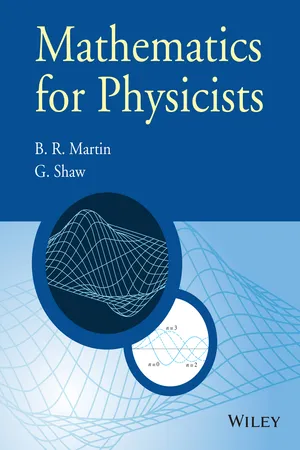Mathematics
Differentiation
Differentiation is a mathematical process used to find the rate at which a quantity changes. It involves calculating the derivative of a function, which represents the slope of the function at a given point. This process is fundamental in calculus and is used to solve problems related to rates of change, optimization, and finding the behavior of functions.
Written by Perlego with AI-assistance
Related key terms
5 Key excerpts on "Differentiation"
- eBook - ePub
- W Bolton(Author)
- 2012(Publication Date)
- Routledge(Publisher)
Section FCalculus 18 Differentiation 19 Further Differentiation 20 Maxima and minima 21 Integration 22 Calculus in action The aims of this section are to enable the reader to:- Identify Differentiation in terms of the gradient of a graph and rate of change.
- Differentiate basic equations from first principles and use standard rules.
- Differentiate algebraic, trigonometric, exponential and logarithmic equations.
- Differentiate products, quotients and functions of a function.
- Determine second derivatives.
- Determine maxima and minima.
- Identify integration as the inverse of Differentiation and also as the area under a graph.
- Integrate algebraic, trigonometric and exponential equations.
- Use integration to determine the area under graphs.
- Solve engineering problems involving the use of Differentiation or integration.
This section is an introduction to calculus. Chapter 18 is an introduction to Differentiation and Chapter 19 extends this introduction. Chapter 20 shows the application of Differentiation to the determination of maxima and minima. Chapter 21 is an introduction to integration. Chapter 22 shows applications of Differentiation and integration in the solution of engineering problems involving straight-line motion, work and circuits involving capacitors and inductors.Dexterity with algebraic equations and graphs is assumed. Chapters 18 , 19 and 21 assume that Chapter 17 has been completed. Chapter 22 assumes that Chapters 18 and 21 have been completed.Passage contains an image
18 Differentiation
18.1 Introduction
Differentiation - eBook - ePub
- Gregory Hill, Mel Friedman(Authors)
- 2013(Publication Date)
- Research & Education Association(Publisher)
CHAPTER 5
Applications of Differentiation
CHAPTER 5
APPLICATIONS OF Differentiation
5.1INTRODUCTION
As with all mathematical concepts, the power of Differentiation comes from applying its concepts either to expanding our understanding of further mathematics or to explaining observed real-life situations. Derivatives can be used for both of these pursuits. Since they allow us to measure change—both instantaneous and average rates of change—and since functions and the world around us are not static, this chapter applies derivatives to the study of function behavior and real-world applications.5.2FUNCTIONS AND FIRST-DERIVATIVE APPLICATIONS
LOCAL EXTREME VALUES
One of the most important applications of calculus is determining maximum or minimum values for situations that involve many options. For example, manufacturers desire to maximize profits on items they produce. Profits will fluctuate depending on a variety of variables, such as overhead costs, selling price, or market conditions. In industry, the problem often is analyzed with numerical models, or by using multivariable calculus. The foundations of these processes begin with simple optimization, as experienced in this course. Set as goals the development of both an intuitive understanding of maxima and minima and a mastery of the analytic work behind determining them.Figure 5.1 shows examples of local maxima and minima and the various ways they can occur on the graph of a function.Figure 5.1The abscissa is considered the location of a local maximum or minimum, and the ordinate is the actual maximum or minimum value. For example, a correct statement is, “The graph of h(x) has a local maximum of h(b) at x = b.” Informally, a local maximum is the highest point in a small interval, and a local minimum is the lowest point in a small interval. In Figure 5.1 , local maxima exist at b, d, and f. Local minima occur at a, c, and e. Notice, with the exception of the endpoints, that local extrema (high or low points) exist where the slope of the tangent is zero (b, c, and e), or undefined (d - eBook - ePub
- Brian R. Martin, Graham Shaw(Authors)
- 2015(Publication Date)
- Wiley(Publisher)
3 Differential calculusThe introduction of the infinitesimal calculus, independently by Newton and Leibnitz in the late seventeenth century, was one of the most important events not only in the history of mathematics but also of physics, where it has been an indispensable tool ever since.In this chapter and the one that follows, we introduce the formalism in the context of functions of a single variable. We start by considering Differentiation, the calculation of the instantaneous rate of change of a function as its argument changes. So, for example, given a function x(t), which specifies the position of a particle moving in one dimension as a function of time t, the operation of Differentiation yields a function representing the velocity. The inverse operation, called integration, will be discussed in Chapter 4 and enables the position x(t) to be deduced from and the value of x at some time, for example t = 0. These two operations – Differentiation and integration – play a crucial role in understanding not only mechanics, but the whole of physical science. Both rest on ideas of limits and continuity, to which we now turn.3.1 Limits and continuity
In previous chapters, we have used the ideas of limits and continuity in simple cases where their meaning is obvious. In this section we shall define them more precisely, before showing how they lead naturally to the idea of Differentiation in Section 3.2 - eBook - ePub
- Frank Werner, Yuri N. Sotskov(Authors)
- 2006(Publication Date)
- Routledge(Publisher)
4 Differentiation
In economics, there are many problems which require us to take into account how a function value changes with respect to small changes of the independent variable (e.g. input, time, etc.). For example, assume that the price of some product changes slightly. The question is how does this affect the amount of product customers will buy? A useful tool for such investigations is differential calculus, which we treat in this chapter. It is an important field of mathematics with many applications, e.g. graphing functions, determination of extreme points of functions with or without additional constraints. Differential calculus allows us to investigate specific properties of functions such as monotonicity or convexity. For instance in economics, cost, revenue, profit, demand, production or utility functions have to be investigated with respect to their properties. In this chapter, we consider functions f : Df → ℝ depending on one real variable, i.e. Df ⊆ ℝ.4.1 LIMIT AND CONTINUITY
4.1.1 Limit of a function
One of the basic concepts in mathematics is that of a limit (see Definition 2.6 for a sequence). In this section, the limit of a function is introduced. This notion deals with the question of which value does the dependent variable y of a function f with y = f (x) approach as the independent variable x approaches some specific value x0 ?Definition 4.1 The real number L is called the limit of function f : Df → ℝ as x tends to x0 if for any sequence {xn } with xn ≠ x0 , xn ∈ Df , n = 1, 2, . . . , which converges to x0 , the sequence of the function values {f (xn )} converges to L.Thus, we say that function f tends to number L as x tends to (but is not equal to) x0 . As an abbreviation we writeNote that limit L must be a (finite) number, otherwise we say that the limit of function f as x tends to x0 does not exist. If this limit does not exist, we distinguish two cases. If L = ±∞, we also say that function f is definitely divergent as x tends to x0 , otherwise function f is said to be indefinitely divergent as x tends to x0 - Khalid Khan, Tony Lee Graham(Authors)
- 2018(Publication Date)
- CRC Press(Publisher)
6 Introduction to Calculus6.1 Differentiation6.1.1 Definition of a LimitFor a straight line, to find the slope (or gradient ) of the line, which is the same across the whole line, it is the change in y against the change in x (Figure 6.1 ).Figure 6.1The slope of a line given as a change in y against a change in x .The formula for the slope is given as m , wherem =6.1=change in ychange in xΔ yΔ x6.1What happens if we have some general curve as shown in Figure 6.2 . What is meant by the slope of this curve? Clearly, the slope is changing at different points. So, the slope at a given point P can be found by saying that this is also the slope of the tangent line at that point, as shown in Figure 6.3 .Figure 6.2 Finding slopes of a general curve.Figure 6.3 The slope of a curve as the slope of the tangent line.At different points the slope would be different because of the different tangent lines at those points. To find the slope at the different points derivatives and limits are used. Consider the curve given in Figure 6.4 . To find the slope at point P, another point Q near to P is considered. The slope of the line joining P to Q, that is, the secant line, is an approximation to the slope at P. So, the closer Q gets to P the better the approximation of the slope at P. The slope of the line PQ is given by using Equation 6.1 asFigure 6.4 Finding the slope of a general curve at a point P.Slope of PQ =6.2=f ( x + h ) − f ( x )x + h − xf ( x + h ) − f ( x )h6.2Now by letting h → 0, the line PQ becomes the tangent line at P to the curve, which is the just slope of the curve at the point P. Therefore, the slope at the point P is defined asThis is the definition of the derivative, that is, the slope of a curve at a particular point P. This definition can be used to find slopes of different curves and to derive a general formula.Slope =6.3=d yd xlim h → 0f ( x + h ) − f ( x )h6.3Example 6.1Review the curve y = x 2 in Figure 6.5 . Using the formula given by Equation 6.3
Learn about this page
Index pages curate the most relevant extracts from our library of academic textbooks. They’ve been created using an in-house natural language model (NLM), each adding context and meaning to key research topics.




